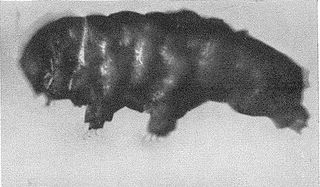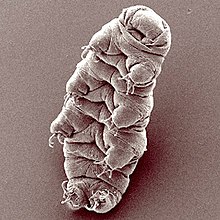
The lobopodians, members of the informal group Lobopodia, or the formally erected phylum Lobopoda Cavalier-Smith (1998), are panarthropods with stubby legs called lobopods, a term which may also be used as a common name of this group as well. While the definition of lobopodians may differ between literatures, it usually refers to a group of soft-bodied, worm-like fossil panarthropods such as Aysheaia and Hallucigenia.
Beorn is a fictional character created by J. R. R. Tolkien, and part of his Middle-earth legendarium. He appears in The Hobbit as a "skin-changer", a man who could assume the form of a great black bear. His descendants or kinsmen, a group of Men known as the Beornings, dwell in the upper Vales of Anduin, between Mirkwood and the Misty Mountains, and are counted among the Free Peoples of Middle-earth who oppose Sauron's forces during the War of the Ring.

The class Heterotardigrada includes tardigrades that have cephalic appendages and legs with four separate but similar digits or claws on each. 444 species have been described.

Eutardigrada are a class of tardigrades (Tardigrada) without lateral appendices. Primarily freshwater bound, some species have secondarily gained the ability to live in marine environments (Halobiotus). By cryptobiosis many species are able to live temporarily in very dry environments. More than 700 species have been described.
Aysheaia is an extinct genus of soft-bodied lobopod, known from the middle Cambrian of North America, with an average body length of 1–6 cm.

Panarthropoda is a proposed animal clade containing the extant phyla Arthropoda, Tardigrada and Onychophora. Panarthropods also include extinct marine legged worms known as lobopodians ("Lobopodia"), a paraphyletic group where the last common ancestor and basal members (stem-group) of each extant panarthropod phylum are thought to have risen. However the term "Lobopodia" is sometimes expanded to include tardigrades and onychophorans as well.

Pyrrhocoroidea is a superfamily of true bugs in the infraorder Pentatomomorpha.

Tardigrades, known colloquially as water bears or moss piglets, are a phylum of eight-legged segmented micro-animals. They were first described by the German zoologist Johann August Ephraim Goeze in 1773, who called them Kleiner Wasserbär. In 1777, the Italian biologist Lazzaro Spallanzani named them Tardigrada, which means "slow steppers".

The Dexiarchia are a suborder of sea slugs, shell-less marine gastropod molluscs in the order Nudibranchia. This classification is based on the study by Schrödl et al., published in 2001, who recognized within this clade two clades Pseudoeuctenidiacea and Cladobranchia.
Zoologischer Anzeiger – A Journal of Comparative Zoology is a peer-reviewed scientific journal specialising in the field of comparative zoology. It is included in a number of bibliographic databases:

Paraprefica is an extinct genus of potoo from the middle Eocene. Its fossil remains have been found in the Messel pit at Messel, Germany.
The Scleronychophora or armoured lobopods are a group of lobopodians that bear a robust dorsal armature of paired plates.

Tactopoda is a proposed clade of protostome animals that includes the phyla Tardigrada and Euarthropoda, supported by various morphological observations. The cladogram below shows the relationships implied by this hypothesis.

Beorn leggi is an extinct species of tardigrades, and the known first fossil tardigrade, discovered c. 1940 and described in 1964 from Late Cretaceous amber from Manitoba, Canada. It is the only species in the genus Beorn, and family Beornidae. It is one of two fossil tardigrades known from the Cretaceous, the other being Milnesium swolenskyi from the Turonian New Jersey amber
Ernstilla is a genus of sea sponges and is the only genus in the monotypic family Ernstillidae. It is represented by a single species Ernstilla lacunosa.
Milnesium swolenskyi is a species of tardigrade from the Cretaceous period. It, Beorn and Paradoryphoribius are the only known tardigrade genera in the fossil record. The type specimen AMNH NJ-796 was found in Turonian New Jersey amber, from about 93.9 to 89.8 million years ago (mya).
Richtersiidae is a family of tardigrades belonging to the order Parachela.

Paradoryphoribius is an extinct genus of tardigrades from the order Parachela. It is the third fossil tardigrade to be named, described in 2021 from Miocene Dominican amber from the Dominican Republic. The type, and currently only species, is P. chronocaribbeus. Paradoryphoribius is the first extinct tardigrade known from the Cenozoic and is also the first tardigrade known from the Miocene. It has a length of 539 microns.

Crenobia is a genus of planarians in the family Planariidae. It is endemic to Europe and Anatolia.











